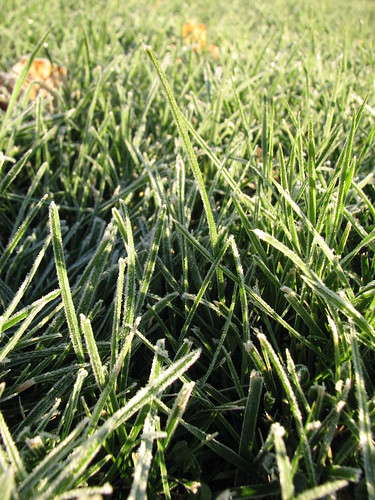Driving to my hometown took us across the vast wasteland of monoculture that I'll refer to simply as Illinois. I could add Missouri and Kentucky to this as well, but in my experience, Illinois seems to take the cake in the world of vast swaths of single crops. Just take a drive on Interstates 70 or 64 and see what I mean. This made me think again of a topic I thought to write about, the lawn - America's favorite monocrop.
The concept of lawn didn't really exist for most Americans until the industrial age. Before then very few could afford the upkeep of a lawn cut by hand. The mowed lawn has it's origin in France and England. Before the invention of the lawnmower, it was mowed by hand or kept short by grazing sheep, cattle and even rabbits. In our time, 58 million Americans spend over $30 billion every year to maintain 23 million acres of lawn. 30 to 60 percent of urban water is used for lawn care. 67 million pounds of synthetic fertilizer are used to keep that turf happy. You see, our modern turf grasses come from other climates. They are basically exotics in the wrong environment, so we spend lots of energy and water trying to keep them green and happy.
As many of us have faced drought this year and most likely next year as well, it would be a good thing to reconsider the lawn (if you haven't already done so). It would be a good thing to consider it even if there wasn't a drought. In full disclosure, we have a rather large lawn. We didn't plant it. We don't water it. What we basically do is mow it. With the drought this year, we mowed rarely and it went dormant for a long period of time. Grass will do that, you don't need to water so much. I promise.
The lawn is slowly shrinking as we increase garden space and beds and fence it in for pasture. It is used as pasture - the geese and ducks are out on it almost every day one of us is home. How much lawn space do you need? Turf grass does make an excellent surface for play. However, beds for flowers and ornamental shrubs are much more interesting than grass. They conserve water, create attractive space for wildlife (especially our little feathered friends), and can easily require less care than turf grass.
Lawns don't have to be grass! Depending on your climate, a lawn can be composed of various ground covers (some are invasive, so check before you plant), moss, and a mixture of plants. Ours is a mixture of pasture grasses, clover, and various other things that pop up. I can't say enough about clover. Bees love it. We love bees. After the horrible late freeze and storms that wiped out our apples, blueberries and greenhouse this spring, beekeepers were asking people not to mow their lawns so that the honey bees could find sustenance in clover. We were more than happy to oblige.
So that's the introduction. Next up - Water Conservation.
I need to get back to the work I get paid for. And, the first of the seed catalogs has arrived - Pinetree Garden Seeds. I've got to start perusing.




I 100% agree.
ReplyDeleteWe have most of our inherited lawn fenced for the sheep---they eat right under our windows sometimes :-D
ReplyDeleteOne of the prettiest "lawns" I have ever seen though is the buffalo grass planted in the dryer regions---no water, no fertilizer, mow once or maybe twice a year. Pretty. Xeriscaping but still with grass if you have to have a "grass fix"
Monica
P.S---yes, lets do keep our fingers crossed for more rain. MORE MORE MORE :-D